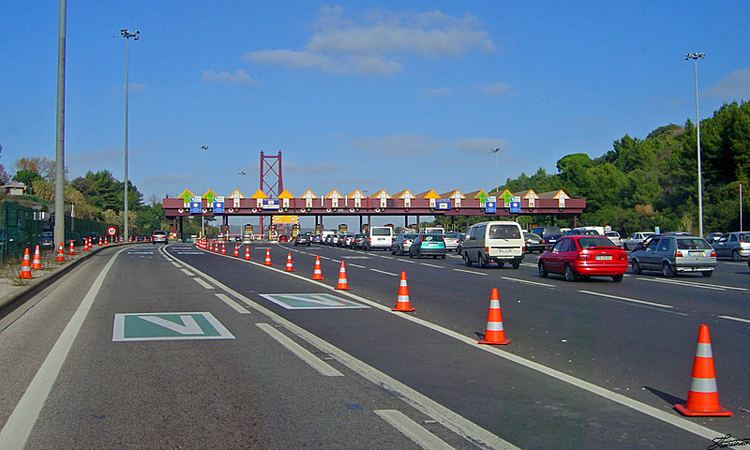 | ||
Headquarters São Domingos de Rana, Portugal Parent organization Brisa – Auto-estradas de Portugal | ||
Via Verde (literally "Green Lane") is an electronic toll collection system used in Portugal since 1991. It is available at all toll roads and bridges in the country since 1995. Toll roads and bridges are operated by multiple operators, the main being Brisa Brisa - Auto-estradas de Portugal.
Contents
Upon passing in a non-stop lane at a toll, a DSRC tag attached to the vehicle's windshield transmits its identifier and the toll amount is debited directly from the client's bank account. If an exception is detected (the tag is invalid (or non-existent) or the vehicle's class (as detected by the lane sensors) does not correspond to the class encoded in the tag, amongst others) the vehicle is photographed and, if there is indication of fraud, a legal procedure is initiated.
This system provides for a good flow of traffic: usually the non-stop lanes on interchanges have a 40 or 60 km/h speed limit, tolls on the highway (as in between different tolling regions) have a 120 km/h speed limit, and the system has been proven to work at speeds above 200 km/h (which are obviously unsafe, especially on narrow non-stop lanes).
The Via Verde system was the first to be universally applied to all the tolls in a country. Via Verde has gained widespread use in Portugal mainly because it can operate with any bank in the country, as there is a fully integrated cross-bank network (the SIBS network).
Via verde 3
Vehicle Classes
Via Verde/toll works with classes for the various vehicles (see Brisa classes for details).
• Class 1: vehicles with a height (measured vertically at the first axis) that are below 1,10m, with or without trailer.
• Class 2: vehicles with two axes and a height (measured vertically at the first axis) equal or above 1,10 m.
• Class 3: vehicles with three axes and a height (measured vertically at the first axis) equal or above 1,10 m.
• Class 4: vehicles with more than three axes and a height (measured vertically at the first axis) equal or above 1,10 m.
Some Class 2 cars are eligible for a class reduction. This is applicable for Class 2 cars that comply to certain rules (see IMT for details). In general a car has to comply to the next rules: 1100≤h<1300mm (measured vertically at the first axis), 2300<max allowed weight≤3500 kg, passengers ≥ 5, no 4 wheel drive. A list of vehicles that are eligible for this reduction, is available at this IMT website.
In case your car is NOT on this list, but complies with these rules, a special inspection (inspecções extraordinárias) by Controlauto is needed. See the website for locations and prices. With an inspection report: go to a Brisa service point and have your Via Verde box changed to Class 1.
Alternate Uses
Due to the widespread use of the Via Verde, it is now being expanded to other areas outside toll fee collecting. Many carparks, some gas service stations (GALP) and even McDrive (equivalent to DriveThru) are now using it as a possible payment method. This system is fully integrated, which means one tag works everywhere. As of 2015, one McDonald's location in Lisbon accepted Via Verde as a method of payment.
Electronic toll
Since 2011 some highways use a system of ´electronic toll´: no manual or credit card payment is possible anymore. These highways can be recognized by a special sign. This sign and more information on the use of these roads (and what alternative means of payment there are) can be found on the toll for foreigners webpage. The roads that have electronic toll can be found here.
